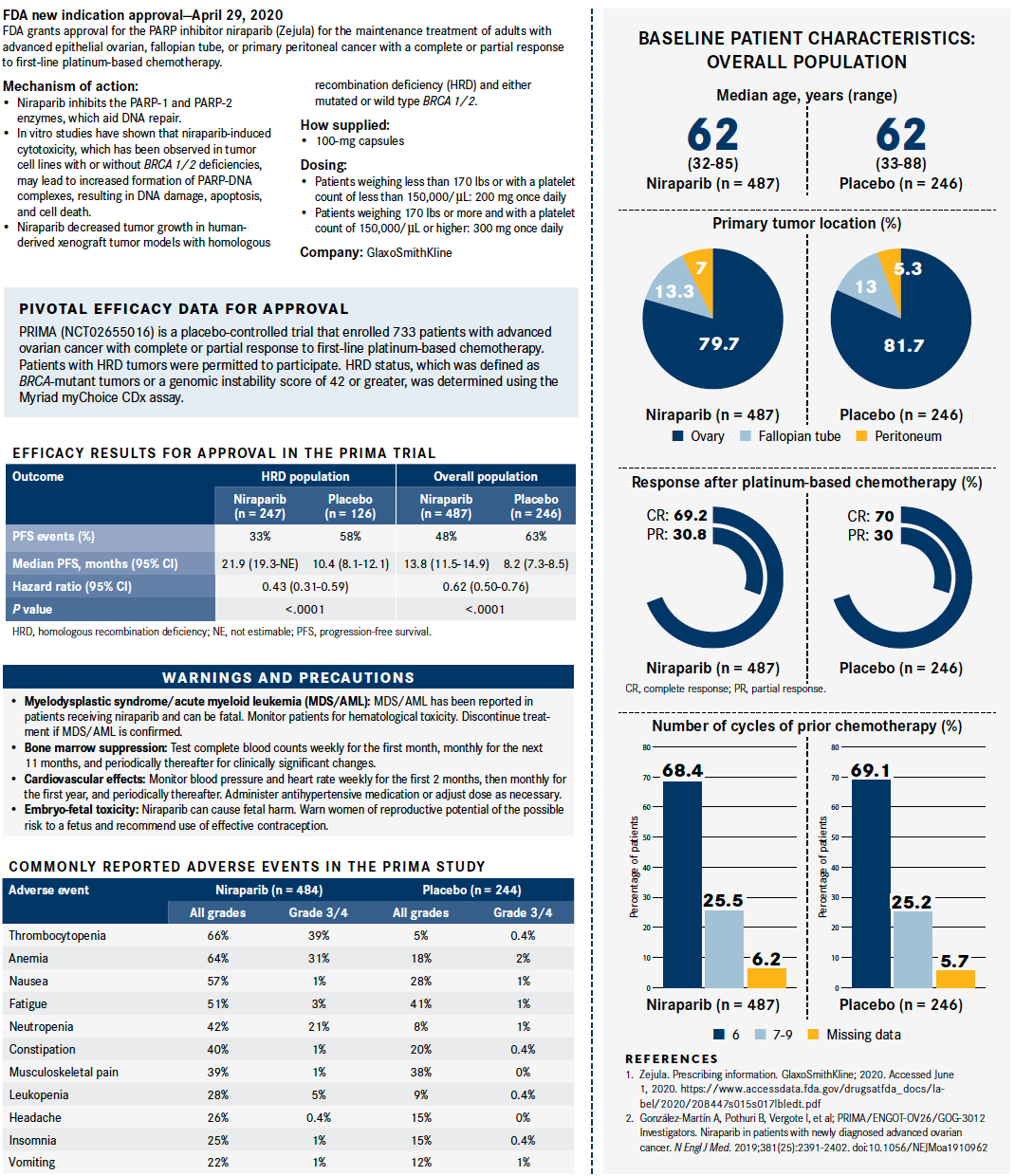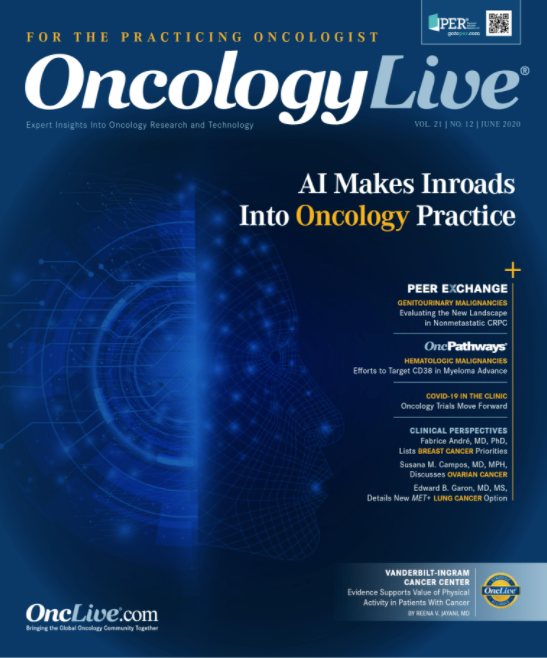Publication
Article
Oncology Live®
Niraparib’s Indication Expands in Ovarian Cancer
Author(s):
Bhavana Pothuri, MD, discusses the practice-changing implications of niraparib’s approval in ovarian cancer.
Bhavana Pothuri, MD

Niraparib (Zejula), a PARP inhibitor that has shown efficacy across various subtypes of ovarian cancer with a manageable safety profile, finds further utility in a broader population of patients with this disease.
On April 29, 2020, the FDA approved niraparib as a maintenance therapy for adults with advanced epithelial ovarian, fallopian tube, or primary peritoneal cancer with a complete or partial response to first-line platinum-based chemotherapy.
Niraparib’s latest approval is based on progression-free survival (PFS) data from the phase 3 PRIMA study (NCT02655016), which demonstrated a statistically significant improvement in both PRIMA’s homologous recombination deficiency (HRD) subset and overall population. The median PFS among patients with HRD was 21.9 months with niraparib compared with 10.4 months with placebo (HR, 0.43; 95% CI, 0.31-0.59; P <.0001). In the overall population, the median PFS was 13.8 months in the niraparib arm and 8.2 months in the placebo arm (HR, 0.62; 95% CI, 0.50-0.76; P <.0001).
In an interview with OncLive®, Bhavana Pothuri, MD, a lead author on the PRIMA study and a professor in the Department of Obstetrics and Gynecology at New York University Grossman School of Medicine, and a gynecologic oncologist at New York University Langone Perlmutter Cancer Center, both in New York, discusses the practice-changing implications of niraparib’s approval.
OncLive: Please provide an overview of the patient population.
Pothuri: The PRIMA study enrolled 733 women with advanced high-grade ovarian cancer or endometrial ovarian cancer [who] were randomized to receive either niraparib or placebo, and then stratified based on whether or not they had received neoadjuvant chemotherapy, whether their response to chemotherapy was a complete or a partial response, and finally, whether there was homologous recombination deficiency.
Patients initially received a fixed dose of niraparib at 300 mg once a day, but about two-thirds of the way through this study, this [regimen] was amended to give patients an individualized dose of either 200 mg or 300 mg based on their baseline body weight and platelet count.
PRIMA included patients who had high risk of relapse: 35% of patients had stage IV disease. About 51% of patients had HRD tumors.
What was notable about the survival data that led to the approval?
PRIMA used a hierarchical analysis of progression-free survival. The HRD population was evaluated first, and the median progression-free survival was significantly increased in patients receiving niraparib versus placebo. These data were really impressive, [so] the next step was to look at the overall population. Niraparib significantly improved progression-free survival in both the HRD and the overall population. This is why the FDA approval of niraparib is for the entire [PRIMA] population.
Please describe niraparib’s safety profile.
The safety data that we saw in this trial was consistent with what was reported previously in the [ENGOT-OV16/] NOVA trial, [NCT01847274; where] the most common adverse events were anemia, nausea, and thrombocytopenia.
Thrombocytopenia has been one of the [problematic toxicities] with this drug. We prospectively evaluated data from the PRIMA trial and adjusted [them] for [patients who weighed] less than 77 kg or had a platelet count of less than 150,000. When [we began]individualized dosing, the blinded, pooled safety data noted that the incidence of grade 3 or higher hematologic and nonhematologic toxicities decreased.
There was [also] a greater than 60% reduction in grade 3 or grade 4 thrombocytopenia, and grade 4 thrombocytopenia and platelet transfusions decreased by 80%.
We conducted quality-of-life analyses to see if these higher-risk hematologic toxicities impacted overall health-related quality of life. The preliminary data that have been presented so far seem to suggest that there is no [effect].
What is niraparib’s mechanism of action?
Niraparib is a PARP inhibitor, [which is] of interest in ovarian cancer due to the loss of the DNA repair machinery in high-grade serous epithelial ovarian cancer and high-grade endometrial ovarian cancer. [This allows us] to exploit this deficiency for a therapeutic advantage, [which] is known as synthetic lethality. There are 2 main pathways that are important for this repair of double-stranded DNA breaks, either through homologous recombination or nonhomologous and rejoining pathways.
How does the approval of niraparib advance the ovarian cancer paradigm?
Niraparib establishes a new standard of care for women with platinum-sensitive recurrence who have had a response to platinum-based chemotherapy. Prior to this study, only patients with BRCA1 or BRCA2 mutations [received] a PARP inhibitor in the frontline setting, so the ability to move a PARP inhibitor into the up-front setting is incredible.
Niraparib is currently listed as a maintenance option following frontline therapy in the NCCN [National Comprehensive Cancer Network] guidelines for ovarian cancer. This approval is a huge win for our patients with ovarian cancer because niraparib is approved for use regardless of BRCA status, HRD, or histology, and does not require a companion diagnostic.
What are the next steps for this agent?
Studies are currently ongoing with combinations of niraparib [including] checkpoint inhibitors, antiangiogenesis agents, and other targeted therapies. It will be important to see if we can further improve upon these results.
[Many] trials have been performed in patients who had never received a PARP inhibitor, so the challenge is [determining] what we do for patients who have already been treated with a PARP inhibitor during frontline maintenance therapy. Will PARP inhibitors have activity after upfront therapy in certain patients? Further studies are going to help elucidate some of these questions.
How does this approval expand niraparib’s utility in ovarian cancer?
As stated above, the approval is for all-comers who have had a response to initial platinum-based chemotherapy in the frontline setting. We have been talking about maintenance therapy, [but] niraparib was also approved in October of 2019 [based on results from] the phase 2 QUADRA trial [NCT02354586]. Niraparib’s approval for platinumsensitive patients with recurrent ovarian cancer and HRD was due to the response rate that was seen in this study.
Niraparib is the first PARP inhibitor to be approved beyond just BRCA1 and [BRCA]2 [and] expands therapy for treatment beyond the biomarker-positive population to patients [with HRD, who] account for about 50% of our ovarian cancers.











